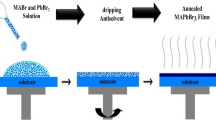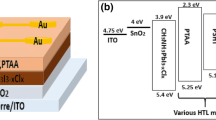Abstract
Due to the poor interface contact between perovskite and the noble metal electrode of perovskite solar cells (PSCs), the stability issues are undoubtedly critical. The main objective of this work is to analyze the workability of rGO-MoS2 nanocomposite as the top electrode. The rGO-MoS2 nanocomposite has been prepared experimentally via the refluxing method. The nanocomposite formation is confirmed via X-ray diffraction and Raman spectroscopy as the peaks of both materials found in the nanocomposites indicate a successive composite of the rGO-MoS2. The electrical properties of the sample are examined via a four-point probe. The lowest sheet resistance (10.7 Ω/sq) was obtained for the ratio rGO-MoS2 (5:5). The optical bandgap of the nanocomposite measured via UV–Vis spectroscopy also shows the narrowest bandgap (1.25 eV), which is ideal for photocatalytic application. The power conversion efficiency (PCE) of the solar cells shows remarkable results of 19.68%, confirming the compatibility of rGO-MoS2 electrode.
Graphical abstract









Similar content being viewed by others
Data availability
The data that support the findings of this study are available from the corresponding author upon reasonable request.
References
C. Zhou, H. Lin, S. Lee, M. Chaaban, B. Ma, Organic–inorganic metal halide hybrids beyond perovskites. Mater Res Lett (2018). https://doi.org/10.1080/21663831.2018.1500951
D. Vikraman et al., Design of WSe2/MoS2 heterostructures as the counter electrode to replace Pt for dye-sensitized solar cell. ACS Sustain. Chem. Eng. 7(15), 13195–13205 (2019). https://doi.org/10.1021/acssuschemeng.9b02430
L. Fagiolari, F. Bella, Carbon-based materials for stable, cheaper and large-scale processable perovskite solar cells. Energy Environ. Sci. 12(12), 3437–3472 (2019). https://doi.org/10.1039/c9ee02115a
Y. Gao et al., Molecular engineering of organic–inorganic hybrid perovskites quantum wells. Nat. Chem. 11(12), 1151–1157 (2019). https://doi.org/10.1038/s41557-019-0354-2
M.K. Rao, D.N. Sangeetha, M. Selvakumar, Y.N. Sudhakar, M.G. Mahesha, Review on persistent challenges of perovskite solar cells’ stability. Sol. Energy 218(February), 469–491 (2021). https://doi.org/10.1016/j.solener.2021.03.005
A. Kojima, K. Teshima, Y. Shirai, T. Miyasaka, Organometal halide perovskites as visible-light sensitizers for photovoltaic cells. J. Am. Chem. Soc. 131(17), 6050–6051 (2009)
L. Liang, Y. Cai, X. Li, M.K. Nazeeruddin, P. Gao, All that glitters is not gold: Recent progress of alternative counter electrodes for perovskite solar cells. Nano Energy 52(May), 211–238 (2018). https://doi.org/10.1016/j.nanoen.2018.07.049
L. Wang, G. Li, Q. Zhao, X. Gao, Non-precious transition metals as counter electrode of perovskite solar cells. Energy Storage Mater. (2016). https://doi.org/10.1016/j.ensm.2016.11.007
N.E. Safie, M.A. Azam, M.F.A. Aziz, M. Ismail, Recent progress of graphene-based materials for efficient charge transfer and device performance stability in perovskite solar cells. Int. J. Energy Res. (2020). https://doi.org/10.1002/er.5876
R.N.A.R. Seman, M.A. Azam, M.H. Anib, Graphene/transition metal dichalcogenides hybrid supercapacitor electrode: Status, challenges, and perspectives. Nanotechnology 29(50), 502001 (2018). https://doi.org/10.1088/1361-6528/aae3da
M.A. Azam, N.E. Safie, M. Fareezuan, A. Aziz, R. Noor, A. Raja, Structural characterization and electrochemical performance of nitrogen doped graphene supercapacitor electrode fabricated by hydrothermal method. Int. J. Nanoelectron. Mater. 14(2), 127–136 (2021)
M.A. Azam, E. Talib, R.N.A.R. Seman, Direct deposition of multi-walled carbon nanotubes onto stainless steel and YEF foils using a simple electrophoretic deposition for electrochemical capacitor electrode. Mater. Res. Express (2019). https://doi.org/10.1088/2053-1591/aae293
D. Bogachuk et al., Low-temperature carbon-based electrodes in perovskite solar cells. Energy Environ. Sci. 13, 3880–3916 (2020). https://doi.org/10.1039/D0EE02175J
M. González Laura, R. Daniel, J. Franklin, Current status and trends of carbon-based electrodes for fully solution-processed perovskite solar cells. J. Energy Chem. (2021). https://doi.org/10.1016/j.jechem.2021.11.020
C. Yi, L. Lusheng, G. Peng, Promise of commercialization: Carbon materials for low-cost perovskite solar cells. Chin. Phys. B (2017). https://doi.org/10.1088/1674-1056/27/1/018805/meta
Z. Ku, Y. Rong, M. Xu, T. Liu, H. Han, Full printable processed mesoscopic CH3NH3PbI3/TiO2 heterojunction solar cells with carbon counter electrode. Sci. Rep. 3(February), 2013 (2015). https://doi.org/10.1038/srep03132
J. Chen et al., In-situ synthesis of molybdenum sulfide/reduced graphene oxide porous film as robust counter electrode for dye-sensitized solar cells. J. Colloid Interface Sci. 524, 475–482 (2018). https://doi.org/10.1016/j.jcis.2018.04.046
V. Tran, S.V.N. Pammi, B. Park, Y. Han, C. Jeon, S. Yoon, Nano Energy Transfer-free graphene electrodes for super-flexible and semi-transparent perovskite solar cells fabricated under ambient air. Nano Energy 65(2019), 104018 (2019). https://doi.org/10.1016/j.nanoen.2019.104018
M. Guo et al., Composite electrode based on single-atom Ni doped graphene for planar carbon-based perovskite solar cells. Mater. Des. 209, 109972 (2021). https://doi.org/10.1016/j.matdes.2021.109972
J.J. Jin et al., Efficient and stable flexible perovskite solar cells based on graphene-AgNWs substrate and carbon electrode without hole transport materials. J. Power Sources 482(September), 228953 (2020). https://doi.org/10.1016/j.jpowsour.2020.228953
D. Jalalian, A. Ghadimi, A. Kiani, Modeling of a high performance bandgap graded Pb-free HTM-free perovskite solar cell. Eur. Phys. J. Appl. Phys. 87(1), 10101 (2019). https://doi.org/10.1051/epjap/2019190095
A. Tara, V. Bharti, S. Sharma, R. Gupta, Device simulation of FASnI3 based perovskite solar cell with Zn(O0.3, S0.7) as electron transport layer using SCAPS-1D. Opt. Mater. 119(May), 111362 (2021). https://doi.org/10.1016/j.optmat.2021.111362
B. Sharma, A.S. Mathur, V.K. Rajput, I.K. Singh, B.P. Singh, Device modeling of non-fullerene organic solar cell by incorporating CuSCN as a hole transport layer using SCAPS. Optik 251(October), 168457 (2021). https://doi.org/10.1016/j.ijleo.2021.168457
M. Belarbi, O. Zeggai, S. Louhibi-Fasla, Numerical study of methylammonium lead iodide Perovskite solar cells using SCAPS-1D simulation program. Mater. Today Proc. (2022). https://doi.org/10.1016/j.matpr.2021.12.425
K. Sobayel et al., A comprehensive defect study of tungsten disulfide (WS2) as electron transport layer in perovskite solar cells by numerical simulation. Results Phys. 12(December), 1097–1103 (2019). https://doi.org/10.1016/j.rinp.2018.12.049
H. Alipour, A. Ghadimi, Optimization of lead-free perovskite solar cells in normal-structure with WO3 and water-free PEDOT: PSS composite for hole transport layer by SCAPS-1D simulation. Opt. Mater. 120(July), 111432 (2021). https://doi.org/10.1016/j.optmat.2021.111432
A.K. Kang, M.H. Zandi, N.E. Gorji, Simulation analysis of graphene contacted perovskite solar cells using SCAPS-1D. Opt. Quantum Electron. 51(4), 1 (2019). https://doi.org/10.1007/s11082-019-1802-3
S. Zandi, P. Saxena, N.E. Gorji, Numerical simulation of heat distribution in RGO-contacted perovskite solar cells using COMSOL. Sol. Energy 197(December), 105–110 (2020). https://doi.org/10.1016/j.solener.2019.12.050
X. Zhu, D. Li, X. Liang, W.D. Lu, Ionic modulation and ionic coupling effects in MoS2 devices for neuromorphic computing. Nat. Mater. 18(2), 141–148 (2019). https://doi.org/10.1038/s41563-018-0248-5
K. Wu, C. Wang, X. Chen, W. Wang, Y. Yang, Facile synthesis of hydrophobic MoS2 and its activity and stability in the hydrodeoxygenation reaction. New J. Chem. 43(6), 2734–2739 (2019). https://doi.org/10.1039/c8nj05980b
P.K. Narayanam, P. Soni, V.D. Botcha, G. Singh, S.S. Major, Transparent and hydrophobic ‘Reduced Graphene Oxide-TiO2’ nanocomposites for non-wetting device applications materials chemistry division. Mater Chem Met Fuel Cycle Group (2018). https://doi.org/10.1021/acsanm.8b01302
J. Chen, Y. Xia, J. Yang, B. Chen, Fabrication of monolayer MoS2/rGO hybrids with excellent tribological performances through a surfactant-assisted hydrothermal route. Appl. Phys. A Mater. Sci. Process. (2018). https://doi.org/10.1007/s00339-018-1843-7
K.D. Rasamani, F. Alimohammadi, Y. Sun, Interlayer-expanded MoS2. Mater. Today 20(2), 83–91 (2017). https://doi.org/10.1016/j.mattod.2016.10.004
F.J. Burgos, I. Llorente, Synthesis of Cu/rGO composites by chemical and thermal reduction of graphene oxide. J. Alloys Compd. 800, 379–391 (2019). https://doi.org/10.1016/j.jallcom.2019.06.008
A.K. Gautam, M. Faraz, N. Khare, Enhanced thermoelectric properties of MoS2 with the incorporation of reduced graphene oxide (RGO). J. Alloys Compd. 838, 155673 (2020). https://doi.org/10.1016/j.jallcom.2020.155673
C. Li et al., Engineering graphene and TMDs based van der Waals heterostructures for photovoltaic and photoelectrochemical solar energy conversion. Chem. Soc. Rev. 47(13), 4981–5037 (2018). https://doi.org/10.1039/c8cs00067k
W. Wang et al., Self-assembled MoS2/rGO nanocomposites with tunable UV-IR absorption. RSC Adv. 8(5), 2410–2417 (2018). https://doi.org/10.1039/c7ra12455d
Abid, P. Sehrawat, S.S. Islam, P. Mishra, S. Ahmad, Reduced graphene oxide (rGO) based wideband optical sensor and the role of temperature, defect states and quantum efficiency. Sci. Rep. (2018). https://doi.org/10.1038/s41598-018-21686-2
Y. Wang et al., Sulfur-doped reduced graphene oxide/MoS 2 composite with exposed active sites as efficient Pt-free counter electrode for dye-sensitized solar cell. Appl. Surf. Sci. 452, 232–238 (2018). https://doi.org/10.1016/j.apsusc.2018.04.276
Y. Jin, Y. Zheng, S.G. Podkolzin, W. Lee, Band gap of reduced graphene oxide tuned by controlling functional groups. J. Mater. Chem. C 8(14), 4885–4894 (2020). https://doi.org/10.1039/c9tc07063j
E.E. Benson et al., Balancing the hydrogen evolution reaction, surface energetics, and stability of metallic MoS2 nanosheets via covalent functionalization. J. Am. Chem. Soc. 140(1), 441–450 (2018). https://doi.org/10.1021/jacs.7b11242
E. Widianto, A. Shobih, E.S. Rosa, K. Triyana, N.M. Nursam, I. Santoso, Performance analysis of carbon-based perovskite solar cells by graphene oxide as hole transport layer: Experimental and numerical simulation. Opt. Mater. 121(June), 111584 (2021). https://doi.org/10.1016/j.optmat.2021.111584
M.S. Shamna, K.S. Nithya, K.S. Sudheer, Simulation and optimization of CH3NH3SnI3 based inverted perovskite solar cell with NiO as Hole transport material. Mater. Today Proc. 33, 1246–1251 (2019). https://doi.org/10.1016/j.matpr.2020.03.488
S. Nair, J.V. Gohel, Impact of stress testing and passivation strategies on low-cost carbon-based perovskite solar cell under ambient conditions. Opt. Mater. 117(May), 111214 (2021). https://doi.org/10.1016/j.optmat.2021.111214
S.G. Hashmi et al., High performance carbon-based printed perovskite solar cells with humidity assisted thermal treatment. J. Mater. Chem. A 5(24), 12060–12067 (2017). https://doi.org/10.1039/c7ta04132b
J. Verschraegen, M. Burgelman, Numerical modeling of intra-band tunneling for heterojunction solar cells in scaps. Thin Solid Films 515(15 SPEC. ISS), 6276–6279 (2007). https://doi.org/10.1016/j.tsf.2006.12.049
Acknowledgments
Authors are thankful to Universiti Teknikal Malaysia Melaka for the facilities support of this work and UTeM Zamalah Scheme for PhD support of Nur Ezyanie Safie. Authors also express heartfelt gratitude to Dr. Marc Burgelman and his staff (University of Gent, Belgium), for developing the SCAPS-1D 3.3.10 simulation software and making it accessible for all.
Author information
Authors and Affiliations
Corresponding author
Ethics declarations
Conflict of interest
There are no conflicts of interest to declare.
Rights and permissions
About this article
Cite this article
Safie, N.E., Sairi, M.N.F.M., Azam, M.A. et al. Development and analysis of rGO-MoS2 nanocomposite as top electrode for the application of inverted planar perovskite solar cells via SCAPS-1D device simulation. Journal of Materials Research 37, 3372–3383 (2022). https://doi.org/10.1557/s43578-022-00652-9
Received:
Accepted:
Published:
Issue Date:
DOI: https://doi.org/10.1557/s43578-022-00652-9




